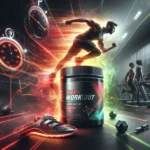Introduction: Understanding How Long Does Pre-Workout Last
Ever taken your pre-workout supplement only to feel the energy crash during your most intense sets? Or wondered why some days your pre-workout seems to power you through a 2-hour session while other days it barely lasts 30 minutes?
You’re not alone. The question of how long pre-workout lasts is one of the most common concerns among fitness enthusiasts, and for good reason. Timing your supplement intake correctly can make the difference between a record-breaking workout and hitting the wall prematurely.
Most pre-workout supplements typically provide benefits for 1-3 hours, but this timeframe can vary significantly based on numerous factors—from the specific ingredients to your individual physiology and even what you ate for lunch.
In this comprehensive guide, we’ll explore everything you need to know about maximizing your pre-workout effectiveness, including the science behind ingredient duration, optimal timing strategies, and practical tips to extend your performance window.
The Science Behind Pre-Workout Duration
What Determines How Long Pre-Workout Lasts?
Understanding how long pre workout lasts requires looking at the pharmacokinetics—how supplements move through and get processed by your body. Different ingredients have different half-lives (the time it takes for half of the substance to be metabolized), which directly impacts their duration of effectiveness.
The typical pre-workout formula contains multiple active ingredients, each with its own timeline. This creates what sports nutritionists call a “cascade effect,” where different compounds peak and decline at different rates.
Primary factors affecting pre-workout duration include:
- Ingredient composition – The specific mix of stimulants, vasodilators, and performance enhancers
- Dosage levels – Higher concentrations typically last longer (within limits)
- Individual metabolism – How quickly your body processes these compounds
- Tolerance development – Regular users may experience shorter durations due to adaptation
Your body’s unique biochemistry means that how long pre-workout lasts for you specifically might differ significantly from what’s on the label or what your workout partner experiences.
Key Ingredients and Their Duration Windows
To truly understand how long pre-workout lasts, you need to know the duration profiles of its key ingredients:
Caffeine: As the primary stimulant in most pre-workout formulas, caffeine has a half-life of approximately 5-6 hours but reaches peak blood concentration within 30-60 minutes. The performance-enhancing effects typically remain strong for 1-3 hours, with residual effects potentially lasting longer.
Beta-Alanine: This amino acid produces the characteristic “tingles” (paresthesia) that peak within 15-30 minutes of consumption and typically subside within 30-45 minutes. However, its performance benefits on muscular endurance can extend 1-2 hours.
Citrulline Malate: This compound enhances nitric oxide production, creating the “pump” effect. It reaches peak concentration in about 30-40 minutes and maintains significant effects for 1-2 hours, gradually diminishing thereafter.
Creatine Monohydrate: Unlike most pre-workout ingredients, creatine works through accumulation rather than acute spikes. When included in pre-workout, it contributes more to long-term performance rather than immediate effects.
B-Vitamins: These water-soluble vitamins are quickly absorbed and generally metabolized within 4-8 hours, supporting energy production throughout your workout.
L-Tyrosine: This amino acid helps with focus and cognitive performance, typically peaking within 30-60 minutes and lasting 1-3 hours.
Understanding these timeframes helps explain why you might feel different aspects of your pre-workout at different times—the initial surge of energy from caffeine, followed by the pump from vasodilators, with varying durations of focus and endurance effects.
Individual Factors Affecting Pre-Workout Duration
How long does pre-workout last? The answer varies significantly based on individual factors:
Body Composition: Individuals with higher muscle mass and lower body fat percentages may process certain pre-workout compounds differently. Fat-soluble ingredients might have extended half-lives in individuals with higher body fat percentages.
Metabolic Rate: Your basal metabolic rate directly impacts how quickly your body processes pre-workout ingredients. Those with faster metabolisms typically experience shorter duration windows.
Genetic Factors: Genetic variations affect enzyme activity—particularly those involved in caffeine metabolism. Some people are “fast metabolizers” who process caffeine in as little as 2-3 hours, while “slow metabolizers” might feel effects for 8+ hours.
Tolerance Levels: Regular pre-workout users develop tolerance, particularly to stimulants like caffeine. This means the duration and intensity of effects diminish over time without cycling off or increasing dosage.
Food Intake: Taking pre-workout on an empty stomach typically results in faster onset but potentially shorter duration. Consuming it after eating slows absorption but can extend the effect timeline.
Hydration Status: Dehydration can both intensify certain pre-workout effects while potentially shortening their duration. Proper hydration optimizes both the effectiveness and longevity of most pre-workout ingredients.
Optimizing Your Pre-Workout Timing
When to Take Pre-Workout for Maximum Effectiveness
Knowing exactly when to take pre-workout is crucial for maximizing its benefits throughout your training session:
For most standard pre-workout formulations, the ideal consumption window is 20-30 minutes before training. This timing allows the key ingredients to reach peak blood concentration just as you begin your workout.
However, this timing should be adjusted based on:
Workout Type: Strength-focused sessions might benefit from taking pre-workout slightly closer to training time (15-20 minutes before) to capitalize on peak stimulant effects during your heaviest lifts. Endurance workouts may benefit from slightly earlier consumption (30-40 minutes before) to ensure sustained energy availability.
Individual Response: Through trial and error, you might discover your body responds faster or slower than average. Track your optimal personal window by noting when you feel the initial effects (tingles, energy surge) and adjust accordingly.
Formula Type: Some newer, fast-acting pre-workouts claim effects within 10-15 minutes, while extended-release formulations may require 30-45 minutes to reach optimal levels.
Morning vs. Evening Workouts: Morning exercisers might need slightly longer lead times as the body’s metabolism is naturally slower upon waking. Evening trainers should be especially cautious about stimulant timing to avoid sleep disruption.
The goal is to align your workout’s most challenging segments with the peak effectiveness window of your pre-workout supplement.
Signs Your Pre-Workout Is Wearing Off
Recognizing when your pre-workout is beginning to fade helps you plan workout intensity accordingly. Key indicators include:
Physical Signs:
- Noticeable decrease in energy levels and explosive power
- Reduction in “pump” feeling as vasodilation effects diminish
- Return of fatigue that was previously masked
- Increased perceived exertion for the same movements
Mental Signs:
- Decreasing focus and motivation
- Difficulty maintaining training intensity
- Return of distractibility during sets
- Reduced mind-muscle connection
Most users experience a gradual decline rather than a sudden crash, with stimulant effects typically fading first, followed by performance enhancers, and finally the pump-inducing compounds.
Understanding this progression helps you structure your workout to front-load the most demanding movements before the pre-workout effects begin to wane.
Avoiding the Pre-Workout Crash
The dreaded pre-workout crash—that sudden energy plummet after effects wear off—can undermine your training and productivity for hours afterward. Here’s how to prevent it:
Gradual Caffeine Tapering: Choose pre-workouts with extended-release caffeine or blends of quick and slow-acting stimulants to avoid sudden drops.
Strategic Carbohydrate Timing: Consuming fast-digesting carbohydrates about 60-90 minutes into your workout can help maintain energy levels as pre-workout effects diminish.
Hydration Protocol: Drink 8-12 ounces of water every 15-20 minutes during your workout to maintain optimal conditions for ingredient effectiveness.
Proper Dosing: Taking more than the recommended amount often leads to more severe crashes rather than extended benefits. Start with half-doses to assess tolerance.
Complementary Supplements: L-theanine paired with caffeine (at a 2:1 ratio) has been shown to reduce crash effects while maintaining performance benefits.
By implementing these strategies, you can extend how long pre-workout lasts effectively while minimizing the likelihood of post-workout energy crashes.
How to Extend Pre-Workout Benefits Naturally
Nutrition Strategies to Maximize Pre-Workout Duration
What you eat before and during your workout significantly impacts how long pre-workout lasts and how effectively it works:
Pre-Workout Meal Timing: Consuming a balanced meal with moderately fast-digesting carbohydrates, some protein, and minimal fat 2-3 hours before taking pre-workout can provide a sustained energy foundation that extends the supplement’s effectiveness.
Strategic Carbohydrate Implementation: A small serving (15-30g) of fast-digesting carbohydrates taken alongside your pre-workout can extend its effective duration by providing additional fuel sources as the initial stimulant effects begin to wane.
Intra-Workout Nutrition: For sessions lasting longer than 60-90 minutes, consuming a mixture of carbohydrates and essential amino acids during training helps maintain energy levels and extend the perceived benefits of pre-workout.
Foods That Enhance Pre-Workout Effects:
- Beet juice contains natural nitrates that can extend the “pump” effect
- Green tea extract can potentiate caffeine effects
- Coconut water provides electrolytes that support hydration and ingredient transport
Foods to Avoid:
- High-fat meals within 2 hours of pre-workout intake slow absorption
- Dairy products can reduce the absorption rate of certain pre-workout compounds
- Acidic foods might degrade certain unstable pre-workout ingredients
By aligning your nutrition strategy with your pre-workout timing, you can create an optimal environment for extended effectiveness.
Hydration’s Role in Pre-Workout Effectiveness
Proper hydration is perhaps the most overlooked factor in determining how long pre-workout lasts:
Pre-Hydration: Consuming 16-20 ounces of water 2-3 hours before taking pre-workout ensures optimal cellular conditions for ingredient absorption and utilization.
Transport Mechanism: Many pre-workout ingredients rely on proper hydration to efficiently enter the bloodstream and reach target tissues. Dehydration by even 2% can significantly reduce how long pre-workout lasts effectively.
Electrolyte Balance: Maintaining proper sodium, potassium, and magnesium levels enhances neural transmission—the mechanism through which many stimulants in pre-workout exert their effects. Consider electrolyte supplements for longer training sessions.
Hydration Schedule:
- 16-20 oz water 2-3 hours pre-workout
- 8-10 oz water with pre-workout supplement
- 7-10 oz water every 15-20 minutes during exercise
- 16-24 oz water post-workout to aid recovery
This systematic approach to hydration can extend pre-workout effectiveness by 15-30% according to some sports nutrition research.
Training Adaptations to Match Pre-Workout Duration
Structuring your workout to align with how long pre-workout lasts maximizes its benefits:
Front-Load Intensity: Schedule your most demanding exercises and heaviest sets during the first 30-60 minutes of your workout when most pre-workout ingredients are at peak effectiveness.
Strategic Exercise Sequencing: Perform complex, multi-joint movements requiring maximum focus during peak pre-workout effectiveness, transitioning to simpler isolation movements as effects diminish.
Rest Period Management: Slightly shorter rest periods (60-90 seconds) during peak pre-workout effectiveness can capitalize on the heightened energy state, extending to more complete recovery periods (2-3 minutes) as the effects wane.
Split Adaptation: If you regularly find your pre-workout wearing off before session completion, consider splitting workouts differently—perhaps transitioning from full-body to upper/lower or push/pull/legs splits that better align with your supplement’s effective duration.
Matching your training structure to your pre-workout’s effectiveness curve ensures you’re maximizing the investment in your supplement.
Advanced Pre-Workout Strategies
Cycling Pre-Workout for Sustained Effectiveness
To maintain optimal effectiveness and duration of pre-workout supplements over time, implement strategic cycling:
Standard Cycling Protocol: Use pre-workout for 3-4 weeks, followed by 1-2 weeks using stimulant-free alternatives or no supplements.
Tapering Approach: Gradually reduce pre-workout dosage over the final week of a cycle before taking a break, which can reduce withdrawal symptoms in habitual users.
Alternate Formulation Strategy: Rotate between 2-3 different pre-workout products with varying ingredient profiles to prevent adaptation to specific compounds.
Caffeine-Specific Cycling: Since caffeine typically develops the most tolerance, some users maintain non-stimulant pre-workout ingredients while cycling only the stimulant components.
Signs that indicate you should cycle off pre-workout include:
- Diminished effects despite consistent dosing
- Need for increasingly larger doses to feel the same effects
- Shorter duration of effectiveness than when you started
- Disrupted sleep patterns even with proper timing
- Increased anxiety or jitteriness with normal doses
Implementing proper cycling protocols can restore how long pre-workout lasts to near-initial levels after each break period.
Stacking Supplements for Extended Performance
Strategic supplement combinations can effectively extend the performance window beyond what pre-workout alone provides:
Intra-Workout Bridges: Implement easily digestible carbohydrates (highly branched cyclic dextrin or dextrose) combined with essential amino acids 30-45 minutes into your workout to maintain energy levels as pre-workout stimulants begin to decline.
Complementary Non-Stimulant Additions:
- L-Theanine (200mg) can extend the focus benefits of caffeine while reducing jitteriness
- Theacrine provides stimulant-like effects with slower onset and longer duration than caffeine
- Eleuthero (Siberian ginseng) offers adaptogenic properties that support sustained energy
Post-Workout Transition: Rather than experiencing a sharp decline when pre-workout wears off, implement recovery supplements with mild cognitive benefits like rhodiola rosea or ashwagandha to create a smoother energy transition.
When stacking supplements, always introduce one new element at a time and start with minimum effective doses to assess tolerance and effectiveness.
Personalized Pre-Workout Approaches
The ultimate answer to “how long does pre-workout last?” is: it depends on you specifically. Developing a personalized approach yields the best results:
Pre-Workout Journal: Track your experiences with different products, dosages, and timing strategies. Note onset time, peak effectiveness window, when effects begin to diminish, and any crash symptoms.
Sample Tracking Points:
- Time pre-workout consumed: 5:15 PM
- First noticed effects: 5:30 PM (tingles, increased focus)
- Peak effects felt: 5:45-6:45 PM
- Effects began diminishing: 7:00 PM
- Complete wear-off: 8:15 PM
- Sleep quality that night: 7/10
Bioindividuality Factors: Note personal variables like recent meal timing/composition, hydration status, stress levels, and sleep quality, all of which can affect pre-workout duration.
Experimentation Framework: Test different timing protocols (15, 30, 45 minutes pre-workout) on similar training days to identify your optimal window while controlling for other variables.
Through systematic tracking, most users can identify patterns that allow for precise optimization of pre-workout timing and duration for their specific physiology.
Conclusion: Maximizing Your Pre-Workout Experience
Understanding how long pre-workout lasts is essential for optimizing your training performance. While the typical effectiveness window spans 1-3 hours with peak effects during the first 45-60 minutes, your individual experience may vary based on numerous factors.
Key takeaways for maximizing pre-workout duration include:
- Know your ingredients – Different components peak and decline at various rates
- Personalize your timing – Experiment to find your optimal consumption window
- Support with nutrition – Strategic carbohydrate and protein timing extends effectiveness
- Hydrate systematically – Proper fluid intake before, during, and after enhances duration
- Structure workouts strategically – Align your most demanding exercises with peak effectiveness periods
- Implement cycling protocols – Prevent tolerance development to maintain effectiveness
- Listen to your body – Individual response trumps general guidelines
- Stack intelligently – Use complementary supplements to bridge effectiveness gaps
- Track systematically – Document your experiences to identify patterns
- Prioritize quality – Choose reputable products with transparent labeling
By applying these principles, you can transform your pre-workout from a hit-or-miss energy boost to a precisely timed performance enhancement tool that delivers consistent, predictable benefits aligned with your training demands.
Remember that pre-workout supplements should enhance—not replace—proper nutrition, adequate rest, progressive training principles, and intrinsic motivation. When used strategically within a comprehensive fitness approach, understanding how long pre-workout lasts becomes another valuable tool in your performance optimization arsenal.
Take the time to analyze your current pre-workout timing strategy against the principles outlined in this guide. Identify one or two immediate adjustments you can implement in your next training session, and gradually refine your approach based on your personal response. Your perfect pre-workout protocol is out there—it just takes systematic experimentation to discover.
Common Pre-Workout Duration Questions Answered
Frequently Asked Questions About Pre-Workout Duration
Q: How long does pre-workout last if I take a half serving? A: Half servings typically provide similar duration but reduced intensity of effects. Most users report a 1-2 hour window of effectiveness with half doses, compared to 2-3 hours with full doses. The onset may also be slightly delayed with reduced dosages.
Q: Can I extend pre-workout duration by taking more? A: Taking larger doses rarely extends duration significantly and increases risk of side effects like jitters, digestive distress, and more severe crashes. Instead of increasing dosage, focus on proper timing, hydration, and complementary nutrition strategies.
Q: Should I take pre-workout for short (under 60 minute) workouts? A: For brief sessions, consider stimulant-free pre-workouts or half-doses of standard formulations. Since most pre-workouts last 1-3 hours, full doses for short workouts may disrupt sleep or daily activities afterward.
Q: Is it normal for pre-workout to affect sleep even hours after training? A: Yes, especially for those sensitive to stimulants or “slow metabolizers” of caffeine. If you work out within 5-6 hours of bedtime, consider non-stimulant alternatives or reduced dosages. The half-life of caffeine means approximately half remains in your system 5-6 hours after consumption.
Q: How long should I expect pre-workout tingles to last? A: The paresthesia (“tingles”) from beta-alanine typically last 30-45 minutes. If you experience tingles beyond 60-90 minutes, you may be particularly sensitive to this ingredient and should consider formulations with reduced beta-alanine content.
Q: Why does my pre-workout seem to last less time than when I first started? A: This is typically due to tolerance development, particularly to stimulants like caffeine. Implementing a systematic cycling strategy—using pre-workout for 3-4 weeks followed by 1-2 weeks off—can help maintain sensitivity and extend effective duration.
Q: Is it safe to take a second dose if my workout runs longer than expected? A: Generally, taking a second dose within the same training session is not recommended. Instead, keep non-stimulant options like citrulline malate, essential amino acids, or fast-digesting carbohydrates available to extend workout performance without doubling up on stimulants.
Additional Resources
- Pre-Workout Tracking Apps: Supplement timing applications that can help monitor effectiveness windows
- Nutrition Timing Guides: Resources for aligning meal timing with supplement consumption
- Sleep Optimization Resources: Tools for ensuring stimulants don’t interfere with recovery
- Scientific Reviews: Peer-reviewed research on ergogenic aid timing and effectiveness
Disclaimer: This article is for informational purposes only and is not medical advice. Always consult with a healthcare professional before beginning any supplement regimen, particularly if you have underlying health conditions or are taking medications.







